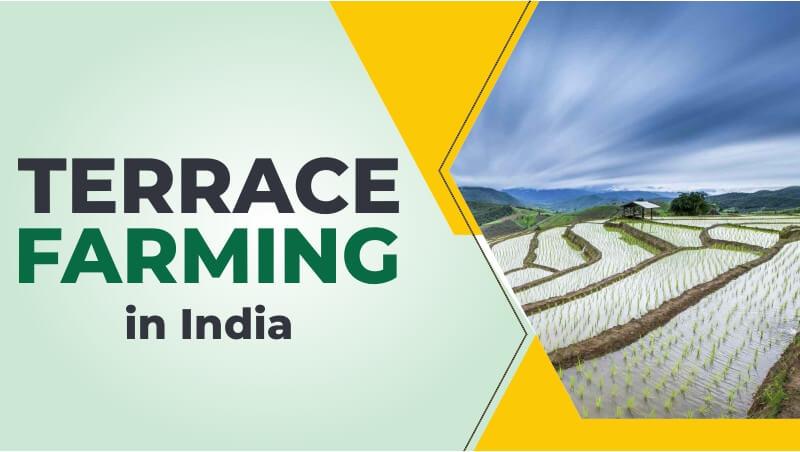Terrace Farming Benefits and Types

What is terrace farming?
Terrace farming refers to the technique of creating flat, levelled steps or terraces on sloping land to facilitate agricultural cultivation. By constructing these terraces, farmers transform steep slopes into manageable and productive farmland. This practice has been employed for centuries across the world, particularly in hilly or mountainous regions, to overcome the challenges posed by rugged landscapes.
Terrace farming is one of the unique types of farming that enables cultivation on steep slopes. Terrace farming, also known as terrace cultivation or step farming, is an ingenious agricultural practice that has revolutionised agricultural practices on sloping terrains. Terrace farming in India is a traditional agricultural technique practised in the hilly regions of the Himalayas and the Western Ghats. Terrace farming is practised in mountainous regions and has revolutionised agriculture by harnessing the power of slopes for sustainable cultivation.
What is terrace cultivation?
Terrace cultivation is a method of farming where flat steps or terraces are created on sloping or hilly land to facilitate agriculture. It prevents soil erosion, conserves water, and maximises land use in challenging terrain. Terrace cultivation is practised in mountainous regions to enhance agricultural productivity and ensure sustainable food production.
Benefits of Terrace Farming
-
Soil Conservation: Terrace farming minimises soil erosion by reducing the velocity of water runoff, thereby preserving the topsoil and preventing nutrient loss. The terraces act as physical barriers, preventing erosion and ensuring long-term soil fertility.
-
Water Management: The terraces in terrace farming allow for efficient water management. They slow down water runoff, promoting water infiltration and reducing the risk of soil erosion. This method ensures better utilisation of water resources and prevents water waste.
-
Increased Agricultural Productivity: By creating level steps, terrace farming optimises the distribution of sunlight, water, and nutrients to crops. This results in improved yields and enhanced agricultural productivity. Additionally, terrace farming allows for diverse crop cultivation, making efficient use of limited land resources. Farmers in terrace farming often employ a tractor to assist in the cultivation and maintenance of their crops.
-
Environmental Sustainability: Terrace farming promotes sustainable agriculture by minimising the negative impacts of farming on the environment. It reduces soil erosion, conserves water resources, and preserves biodiversity by creating habitats for various plant and animal species.
Types of Terrace Farming:
-
Contour farming: Terraces are constructed along the contour lines of the slope, following its natural curves. This method helps slow down water runoff, reduce soil erosion, and improve water retention. Contour cultivation, contour ploughing, and contour farming are agricultural practices that involve working with the natural contour lines of the land to minimise erosion and improve water management.
-
Bench Terracing: In bench terracing, flat platforms or benches are created along the slope, supported by retaining walls. This technique provides stability and prevents soil erosion on steep slopes.
-
Raised-bed Terracing: Raised beds are built on the terraces, creating elevated planting areas. This method improves drainage, prevents waterlogging, and enhances root development for crops.
-
Paddy Terracing: Paddy terracing, also known as rice terracing, is a specialised type of terrace farming for growing rice. It involves creating levelled fields and a complex system of irrigation channels to maintain the necessary water levels for rice cultivation.
-
Strip Cropping: In strip cropping, alternating strips of different crops or vegetation are planted along the terraces. This method helps prevent erosion, conserves soil nutrients, and promotes biodiversity.
-
Step Farming: Step farming involves constructing individual steps or platforms on the slope, resembling a staircase. Each step is used for cultivation, optimising water and nutrient distribution.
-
Multi-layered terracing: This approach involves creating terraces with multiple layers or tiers. It allows for the cultivation of different crops on each level, making efficient use of vertical space.
Visit khetigaadi for information about the tractor, tractor price, and types of farming.
- Art
- Causes
- Crafts
- Dance
- Drinks
- Film
- Fitness
- Food
- Spellen
- Gardening
- Health
- Home
- Literature
- Music
- Networking
- Other
- Party
- Religion
- Shopping
- Sports
- Theater
- Wellness




